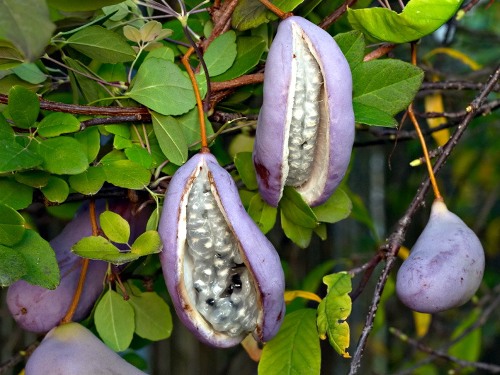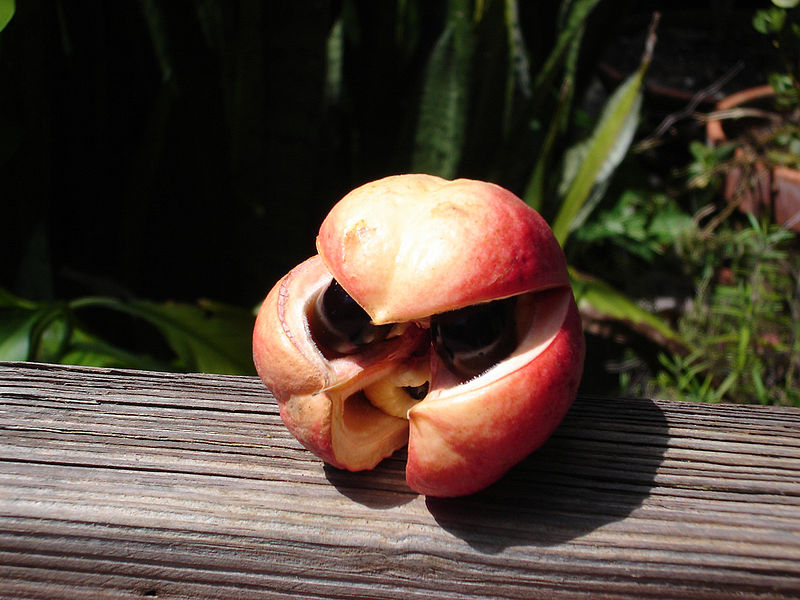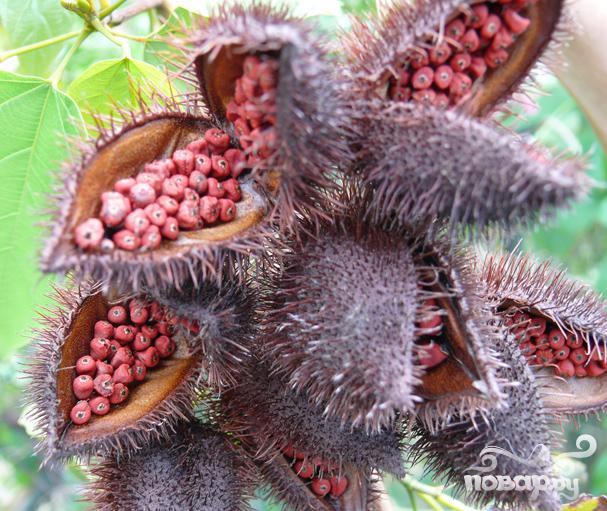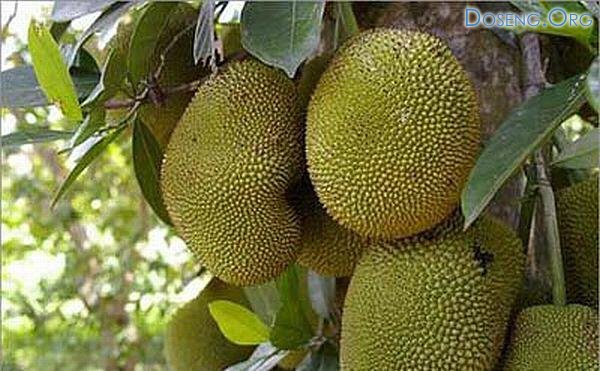Akebia 
Such an unusual lilac-purple fruit you can find in the gardens in the northern part of Japan. Many local people grow it in their own areas like our wild grapes, braided support dense carpet of leaves. When the fruit reaches maturity Akebia, one of its walls "opens". It happens only once a year - at the beginning of autumn. Slightly sticky sweet flesh is eaten as a fruit, bitter thick skin more recalls a vegetable. However, the Japanese, not sharing these flavors, eat Akebia completely.

Dzhabotikaba

The
researchers argue that dzhabotikaba initially grown in southern Brazil,
but later it migrated across the ocean and spread to Portugal and the
Philippines. Its
main peculiarity is that the dark purple, almost black fruits do not
grow on the branches, and specifically on the trunk of the tree, which
locals sometimes call "grape." Juicy "balls" with a taste of wild grapes can be eaten immediately or make their juice, jam or liqueur. Alas,
please relatives unusual souvenir from afar will not work -
dzhabotikaba actually stored and begins to deteriorate after a frisky
day oposlya collection. 
Cherimoya

Another "emigrant" in Latin America - squamous cherimoya. Perhaps
you have seen these green freed from the rigid skin balls on the
shelves of Spanish or Asian markets, and in Egypt, and the smallest bit
unpeeled fruit is sold under the name "eshta." Slice
the fruit, you will find some dark seeds that are best removed (because
they are considered a great emetics), while the taste of delicate
aromatic pulp (which recalls a melon with cream, the rest - the papaya)
is to be commended. For example, Mark Twain called the cherimoya "the most delicious fruit known to man."

Kupuasu

On the ground, a little food, which can boast of being the cause of the interstate scandal. Perhaps only Russian vodka and fruit tree kupuasu - the most expensive fruit in Latin America
And it all began. Back
in the Brazilian jungle, where, as you know, a lot of monkeys, growing
rare even for those places plant, the fruits of which will gladly ate
Aborigines. And so it went, until the local delicacy by some miracle did not get to the enterprising Japanese. They
will appreciate not only the taste but also the commercial potential
kupuasu, patented the name of fruit than terribly offended Brazilians
who requested to return their national heritage.
To
understand what the debate representatives of the two powers, imagine
coconut, stretched like a melon, with a strong citrus smell. Growing this wonder of nature on a small evergreen tree with large, up to 35 centimeters in length, leaves. Within these "kokosodyn" - white, soft, sour-sweet pulp and between 25 and 50 seeds, in five clusters. The fruits appear on the tree throughout the year, but the biggest crop harvested from February to April.
Most interesting is that the food can be consumed only kupuasu who themselves have fallen from the tree. Fruit,
plucked directly from the branch, never ripen fully and get that
wonderful flavor and aroma, which is famous for the resident in the
tropics. The fruit should not be stored and quickly lose flavor, so the meat is frozen and in this form is sent to be recycled.
In local markets kupuasu - the most expensive piece of fruit. This is not surprising. In order to get a crop of fragrant fruit, must be met a lot of conditions. Thus,
growing in the lower tier of rainforest kupuasu not like direct sun -
the leaves are burned, dry up and fall off at the edges. Therefore, the plantation trees are planted in the shade of the higher plants, or cover a special net.
However, all the efforts of the planters are paying off, because kupuasu - is almost non-waste production. The fruit pulp eaten both fresh and used to make juice, liqueur and ice cream. Seeds,
the fifth part of the volume of fruit, half composed of white oil on
properties close to cocoa butter, but having a higher melting point, so
it made of chocolate (kupulat) does not melt in your hands. In addition extract kupuasu actively used in cosmetology. He is often part of the means to care for the skin and hair. It's a great emollient and moisturizer. A
high percentage of fatty acids and in fitosteroidov kupuasu improves
skin elasticity, eliminates irritation, eczema and dermatitis. 
Aki

This
relative of the lychee was born in the tropical forests of West Africa,
where his green fruit traditionally used instead of soap, and later
spread throughout the world. Most
successful "career" Aki did in Jamaica, there is of it even began to
prepare one of the national dishes, despite the fact that the fruit is
poisonous and is it can only cook in boiling water for 10 minutes. Risk is, as Aki provides lots of nutrients and fatty acids.

Annatto

In
tropical areas of North and South America, and in South-East Asia in
the trees quite a lot of red-brown spiky fruit with round crimson seeds
inside. What do they taste, hard to say, because, unlike other fruits, of which we now speak, annatto inedible. But his kaloritnye ruby seeds - excellent food coloring, you may have encountered everywhere, from lipstick to cheddar cheese.

Dzhekfrukt

The man who turned out for the first time in South-East Asia, will just confuse the breadfruit to the notorious durians. Pulp
from them, really, to look very similar, but if the first one smooth
skin covered with large bumps, then they pointed at the extreme, and, of
course, jackfruit pulp from contact with the air begins to smell
disgusting hydrogen sulfide. Breadfruit can be very large - about the size of a watermelon. Its
taste is hard to describe: typically, they say that it is sweet and
pleasant, vaguely reminiscent of mango or melon with lychee finish. 
Magical Fruit

This
fruit from West Africa, in reality, has magical qualities: substance
contained in it mirakulin can affect the taste buds of people. Eat
red berry (do not forget to spit out the bone!) - And for about an
hour, you will not be able to distinguish between a sour taste, but at
least what the product directly to the lemons, you will find sweet.
Kiva
Kiva, from time to time for the African horned cucumber and melon, long
grows not only in his native Africa, and in California, Chile,
Australia and New Zealand. He
looks strange from the outside is covered with orange peel fruit with
thorns, and cut it, you will see the green flesh inside with whitish
seeds. The taste reminds many cucumber, which was crossed with zucchini and banana. There are nods can raw, added to milkshakes and other drinks. Particularly,
he will appeal to the ladies, always sitting on a diet, because, as in
cucumbers, there is practically no calories.
Mangosteen Being in South-East Asia, neotklonimo try these small purple fruit. Just
before eating them, do not forget to remove the thick tough inedible
purple rind, under which you will find a watery gel-like pearly flesh
with black seeds. The taste mangosteen little reminiscent of lychee, but a little more sweet and tart. 
Kumquat

The name of this cute little fruit comes from China. Kumquats - a word of Cantonese, which means "golden orange." Kumquat tougher than most citrus and successfully cultivated in Louisiana, Florida and California.
Kumquat is interesting not only for its looks, but also for its contents. There are a lot of nutrients. This plant contains a lot of different essential oils, which are very often used in the treatment of inhalation, and therefore, the treatment of these essential oils can easily get rid of colds, coughs, and even just the common cold. Its bactericidal effect of this fruit have to keep in its essential oil substance. Thanks to-eat kumquat you can adjust the digestive system, to prevent the formation of gastric ulcers, get rid of stress, apathy and nervous tension.
Because kumquat tolerates transportation, many of us met jams, jellies and marmalades from it. Unlike other citrus fruits, kumquats can be eaten whole, together in the peel. The combination of the sweet taste of the skin and the flesh gives slightly sour kumquat unique taste.

(I personally do not like the creepy kumquat -
 MilaYa__Lyudmila )
MilaYa__Lyudmila ) Durian

The most expensive (and most smelly) fruit in the world - the incomparable durian, a fruit and can fly at $ 100. About to eat, in any case, do not touch it with his hands - the fragrance indelible. Of all the famous durian fruit is so deserved polar characteristics. And if not impossible to imagine how it is true. The smell of durian is so disgusting, that it is not allowed in hotels, shops, elevators, taxis and other public places. There is even a special character - durian, crossed a red line. This means that the entrance to it is denied. After all, even after the fruit eaten in the room remains the "flavor" that his long time can not erode any cosmetics. For the same reason, the durian is not subject to long-term storage and transportation.
What epithets not award its flavor! The smell of rotting flesh, rotting onions, dirty socks, toilet, rotten eggs ... The Englishman, who visited Siam in the 19th century, describes his impressions of durian flavor, "it is akin to eating herring with blue cheese over an open sewer manhole."
And after all this, it is called the "king of fruits"? Is this possible? Perhaps - meet Thais, Malaysians, - if, holding his nose and breaking disgust, you do try durian flesh. Only then will understand how it "divine" taste. Thais say durian, actually tastes sweet and looks like a custard of eggs and milk. According to the famous naturalist Alfred Russel Wallace "Try durian - get this entirely new experience, and a trip to the East is worth it. The more you eat durian, the less you want to be distracted by anything else. " In general, for gourmets, this fruit proudly holds one of the honored place among the well-known "fragrant" delicacies like Chinese "rotten" eggs, Swedish syurstremming and the famous cheese "Roquefort", covered with green mold ...
Name of fruit comes from the Malay word «duri» (thorn) and Malay suffix «an», which means "spiny fruit." Homeland durian - Indonesia, Thailand, India, Ceylon, Indo-China, the Philippines. By the way, it is considered that the most delicious durians are grown on plantations near Bangkok in Thailand. It is also grown in plantations in central Africa and in Brazil. Usually, ripe fruit weighs 3.2 kg, has a diameter of 15-25 cm and 20-30 cm in length. It grows large trees. At the height of 15-20 meters, the first fruits are already allows for 8-10 year. And then bears fruit all year round. Blooms less than eight hours: the bright white flowers open at dusk and fall off at dawn. They say that pollinate their bats. Fetus in any case not tear. Ripe, it should fall by himself. If durians fall down (God forbid!), It had never happened. Individual fruit size with a good soccer ball weighs about 10 kg. Yes, they have sharp spines.
The unripe fruit as locals prepare vegetables cooked in the different dishes and ripe fruits are truly exquisite dessert exceptional taste with a wide range of nutrients. This fruit is rich in carbohydrates, proteins, fats and vitamins. Durian pulp contains a lot of vitamin B complex and vitamin C is much greater than is found in sweet orange. His odor attributed to the presence of organic sulfur, health-restoring properties are just being studied.










Dear Editor, Author, or persons authorized to give copyright permission.
ReplyDeleteI am writing to you to get the permission to use your articles in my book The Foodpedia Fresh Fruits and Vegetables books series and other books will follow, on the history of other items in the food world. That will help the people of the world to eat and stay Healthier. I care and I hope you care about passing on to the new generation to stay Healthier.
(REMEMBER SHARING IS CARING!) I am writing these books to “give back” my knowledge to the next generation of people, all over this world. I writing these books to educate the people about the advantages of eating “Fresh Fruits” and “Fresh Vegetables” and how they can help themselves to have a healthier body, and the foods that are not good for a healthy body.
I got your name from the website. On the Fruit you wrote about. I have your name on the information that I used, so that you will get all the credit on it. I do not want the credit for your works.
I am on a quest (mission) of caring and share to help, not to make the same mistake this generation and our pass generations has made, to help them live healthier lives better then we did. But I need your help to get this mission (movement) going. I need your permission to let this happen, to use your research in food, to train and educate the people of the world to eat healthier. Remember the people will go to your website for more updates. Because you are always updating it, that I cannot do. Can you please e-mail the permission letter to authorize me to use your articles in my books (The History of Fresh Fruits. { Foodpedia The History of Fresh Fruit }) I have about 166 chapters of some of the fresh fruit used around the world, with over 2,000 color pictures and about 5,000 pages), 10-12 volumes.
Can you please email {foodpediapjh@gmail.com } with your permission to use your articles so we can help the this and the next generation to live and be healthier. Thank You Chef Paul J. Hintersteiner Enclosed is the website of the articles I need permission on
http://choppasenoel.blogspot.com/2013/01/rare-and-exotic-fruits.html